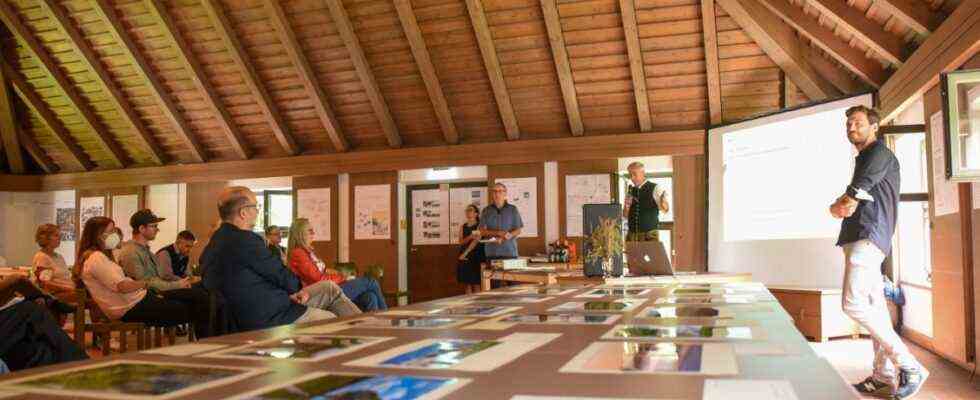The cumbersome title is deceptive, because the Leader project “Baukulturregion Alpenvorland” has created a veritable atmosphere of optimism in Dietramszell. How do we want to live in rural regions in the future, and what could that look like in Dietramszell? The project under the leadership of Elisabeth Leitner, in which Dietramszell is the only municipality in the district, is dedicated to these questions. In addition to workshops and a “Baukultur get-together”, a cooperation with architecture students from the Vienna University of Technology was also part of the project, who presented their results on Friday. The fresh view from the outside gave new impulses, which caused enthusiasm from the citizens in the full parish hall of St. Martin.
A koi carp farm or a cinema in the indoor swimming pool in Ascholding? A new pedestrian and bicycle bridge over the Isar near Ascholding? A multi-generational living including an indoor playground in the former dairy in Baiernrain? The 16 students presented many creative ideas, which probably not all of them can be implemented. Of course there could be no question of castles in the air; In just two months, the young people had thoroughly dealt with the various districts and possible problem areas, concretized their considerations during a one-week stay in the community, talked to citizens and worked out presentations. The most original idea under the motto “Ob ‘zapft is” was presented by a group for the Ascholdingen indoor swimming pool. According to their calculations, 30,000 euros would be needed to turn the ailing bathroom, which will be drained in the foreseeable future, into an event room for 250 people, for example for a “plant bazaar”. With a further 50,000 euros for event technology and a second escape door, the “first Dietramszell cinema” for up to 450 viewers could be built there. “Aquaponics”, a combination of freshwater fish farming and the cultivation of vegetables and lettuce, would also be possible in the pool.
A group had also dared to tackle the delicate subject of Hindenburg. Her suggestion: fetch the bronze head again from the Schilcher family’s cellar, put it upside down in its original place on the monastery wall at the opening of the planned history trail, but only provisionally. A kind of final performance, because afterwards the Hindenburg bronze should disappear forever in a museum in the opinion of the students and the inscription on the monastery wall should be covered with an information board.
The group had also thought about the design of the village center and took current plans into account. The Viennese don’t think that everything has been successful: The plans to “cut through” the Angerwiese with a footpath are taking away a lot of potential from the area; because it could be used as a variable area for events and celebrations. To do this, of course, the history trail planned there would also have to be relocated. Instead of a linear route, the students suggest a tour with information boards at the historical stations in the center of the village. The space in front of the new ice cream parlor, which is developing into a popular meeting place, could be upgraded with more seating and play equipment.
The ideas that the students had developed for the dairy in Baiernrain, which had been vacant for decades, met with great approval. They see the large building complex, which is privately owned, as a model for communal living and working: In the elongated main body, in which there are already apartments, communal forms such as multi-generational living, open-plan offices, a communal workshop and an indoor playground could arise. In the unused threshing floor you could imagine a village shop and a place for the farmers’ market or a Christmas market. According to the students, the roof between the main wing and the side building should be opened, creating an arcade. The councilor shouldn’t let these ideas gather dust in a drawer, warned audience member Waltraud Bauhof, “these are great suggestions.”
Many more were presented in the two and a half hour presentation: e-charging stations and call taxis, an expansion of the bicycle network and a pedestrian and bicycle bridge over the Isar near Ascholding, which would shorten the route to Geretsried. More architectural diversity and more quality when building new stables; Use vacancies and close gaps instead of identifying new residential areas. A new “AK Baukultur” should now deal with the topic further in the community.

